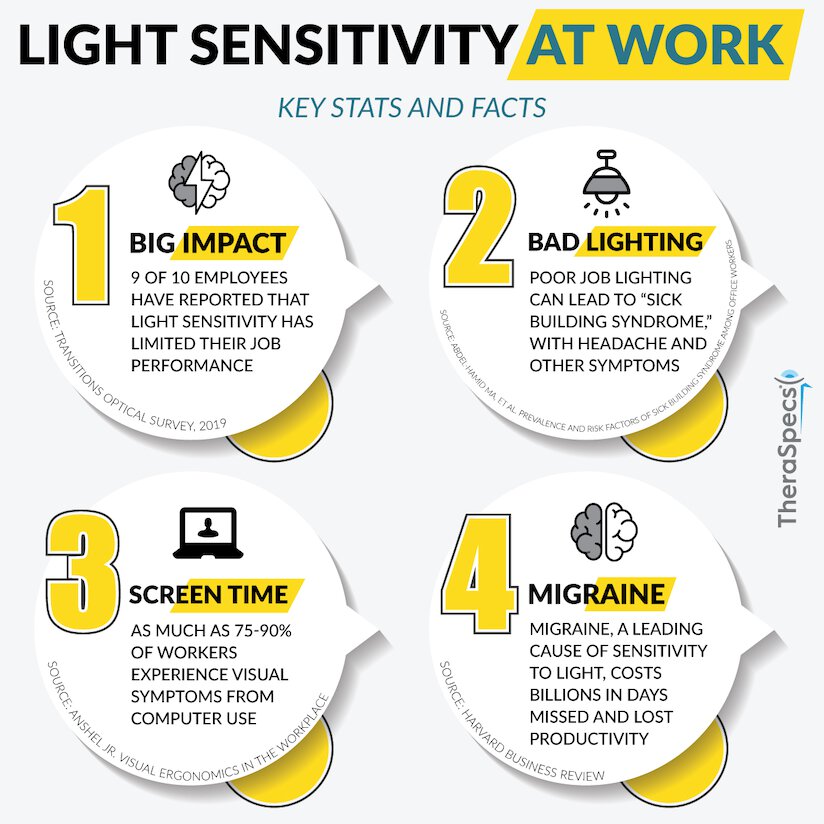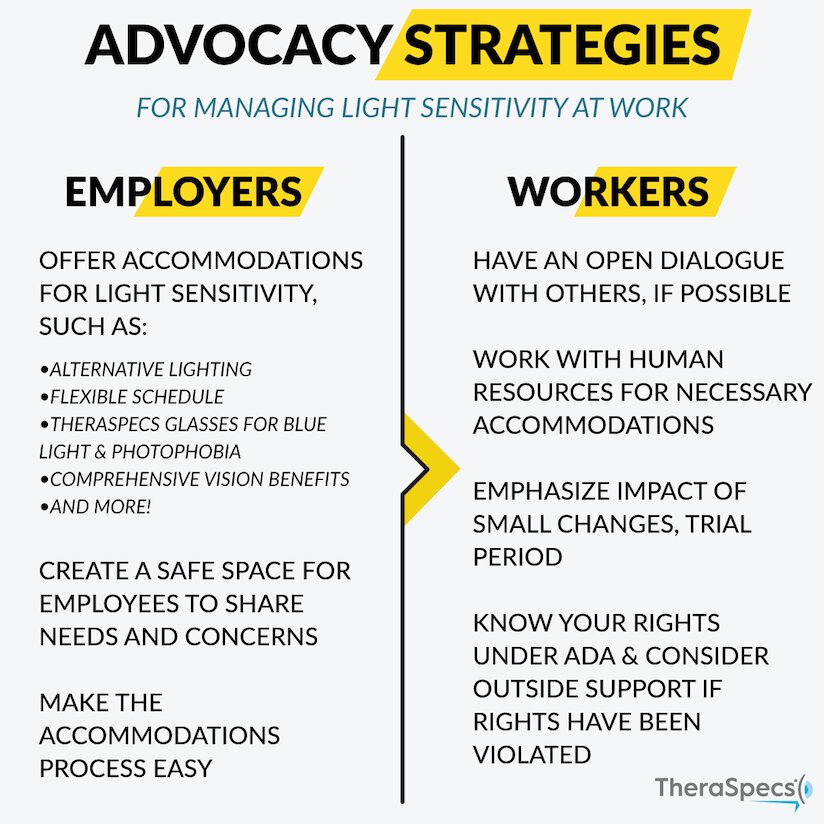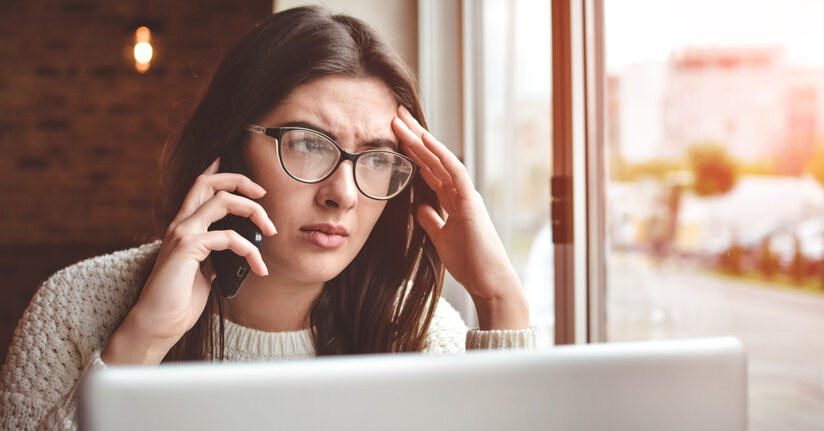Light Sensitivity at Work: Key Stats, Workplace Accommodations and Other Resources
Light sensitivity and photophobia affects millions of people across the globe, and it can take a major toll on the professional lives and work experiences of those individuals too. Here, we explore the impact of light sensitivity in the workplace and identify accommodations that can help improve on-the-job outcomes for people with this symptom.
The Impact of Light Sensitivity in the Workplace (Key Stats)
When you are sensitive to light, particularly chronic and/or as a result of a condition, there is often no escape from the light-related threats in the world. Your workplace, whether it is an office environment, a warehouse, or a factory, is no exception. The millions of people who deal with photophobia have their sensitivities follow them to the job site, which is reflected in the scale of the problem. Here are just a few stats about how prevalent light sensitivity is at work:
- 9 out of 10 employees have reported that light sensitivity has limited the ability to do their job. This includes lower productivity, diminished focus, and the need for more frequent breaks (Transitions Optical Survey, 2019)
- Poor lighting in the workplace was more likely to lead to “sick building syndrome”, which is characterized by symptoms of fatigue and headache1
- Workers generally have a greater dislike of and sensitivity to fluorescent lighting, and those with work-related headache were more likely to find the lighting uncomfortable2
- Computer use has been identified as a direct contributor to visual and neurological problems like eye strain, headache and photophobia; these symptoms occur in as much as 75-90% of workers, according to optometrists3
- 80% of light-sensitive individuals reported an increase in screen time as a result of the COVID-19 pandemic, with the majority using their devices 3+ more hours per day (TheraSpecs COVID-19 Survey, 2020)
- Migraine, along with related sensory symptoms, is the leading cause of global disability for people under 50 years of age. This results in billions lost every year due to days missed and diminished productivity (Harvard Business Review)
- The presence of post-concussion symptoms like headache, photophobia and dizziness are a direct contributor to reduced work quality for people with brain injuries4
- Dry eye, another leading cause of light sensitivity, can reduce work performance by as much as 30 percent.5

Workers are also hungry for their organizations to address issues with lighting and light sensitivity. In one survey, nearly 50% of employees in the US had become more concerned about light sensitivity and eye strain, and they were significantly more likely to enroll in their employer’s vision benefits if it offered protection from harmful blue light.
Another survey revealed that 54% of accommodation requests from federal workers in Canada included some type of technology or assistive device—including adjusted lighting and alternative screen options. Unfortunately, those same individuals often felt dissatisfied with the accommodation process as a whole, and there is additional evidence that employers have been slow to adapt to the needs of light-sensitive workers.
Specifically, HR professionals have acknowledged that there is a lack of understanding about migraine (and related symptoms) in their organizations. More than one-third even said that their workplace was unlikely to make changes in the environment to reduce migraine triggers. Another analysis showed that employers had a knowledge gap in the effects of sensory processing and specifically could not relate to or understand the sensitivity to light among its workers with autism spectrum disorder.6
It is not all doom and gloom though. Many employers seem to be recognizing the impact of virtual work on eye and brain health, and there is greater awareness of the role of blue light protection in overall workplace productivity and wellness. In addition, more and more organizations make alternative lighting options, among other accommodations, available for those with migraine and headache disorders.
Light Sensitivity and the Americans with Disabilities Act (ADA)
Most people, certainly those who have chronic or recurring light sensitivity, would agree that the symptom is disabling—at times extreme. The law, however, has been less clear about whether it is a protected disability in the workplace.
The Americans with Disabilities Act (ADA) provides guidance on the obligation of employers to provide reasonable accommodations for workers with disabilities. There is no specific list for conditions or symptoms that meet the criteria for a protected “disability”, which has led to court judgments on both sides of cases brought under the ADA.
Ultimately, the law treats each situation uniquely. By definition, in order for light sensitivity to be considered a disability, it must substantially hinder one or more major life activities. If it also dramatically impacts you on the job, then you could (and probably should) be entitled to reasonable accommodations from your employer. However, it can be difficult to convince your employer on the impact of photophobia and ultimately to get the exact resources you need, for several reasons. For example:
- Each person experiences photophobia differently, so accommodations will likely need to reflect an individual’s unique needs
- Symptoms of photophobia (and many of the underlying conditions) are invisible, which makes it more challenging to demonstrate the toll on one’s health
- Migraine and other light-sensitive disorders are subject to stigma in the workplace from other colleagues, both in the behaviors and words they may use
- Employers can have varying reactions, systems, and processes associated with accommodations requests
Even with these difficulties, it is still important to try and secure job-related enhancements for your light sensitivity. Now, let’s look at what types of requests may constitute a “reasonable accommodation.”
Reasonable Accommodations for Light Sensitivity
Several options for accommodations exist for employees who have photophobia. Organizations can work with the employee to enact any of the following recommendations in order to help them be more comfortable on the job.
- Provide alternative lighting, especially in spaces with a high density of fluorescent lights.
- Offer flexible work schedules and telecommuting/work-from-home options.
- Grant employee requests to move their primary workspace or change offices where the lighting may be more comfortable.
- Create a designated “recovery” room that features minimal sensory disruptions (e.g. noise, light), which employees can use if they are experiencing an attack or light-sensitive episode.
- Purchase anti-glare covers for monitors and/or alternative screen options or devices for those that require them.
- Purchase TheraSpecs therapeutic glasses, which can be made with a variety of lenses that are designed to reduce the wavelengths of light that trigger photophobia and other symptoms, including harmful blue light from fluorescents and screens. TheraSpecs have been specifically recognized by the Job Accommodation Network for light sensitivity.
- Encourage the use of screen-related accessibility features, such as dark mode. Certain apps that regulate color temperature (such as f.lux) can be installed on devices as well.
- Offer a comprehensive vision benefits package.
- Allow for a flexible dress code for those with light sensitivity, such as allowing people to wear a hat on the job or specially-tinted eyewear.
- Promote and facilitate healthy visual ergonomics, including proper workstation setup and lighting management strategies, both onsite and at home.
- Work with the employee to reduce exposure to other triggers, such as noise or smell, especially if control over lighting is limited.
- Establish educational programs around the impact/needs of light sensitivity and light-sensitive conditions like migraine, which have been shown to have a direct reduction in employer costs.7
Ultimately, it is incumbent upon the organization (and its key representatives) to be a strong advocate for people with light sensitivity. That extends beyond the offering of workplace accommodations; they should create a safe environment for those with sensory issues, not just free of light triggers but a culture where they can feel comfortable sharing their needs and concerns. They should also work to make the accommodations process as smooth and easy as possible. It’s hard enough to live with photophobia, and employees don’t need the added stress of workplace inflexibility.
Advocacy Strategies and Other Resources for Employees
We want to reinforce that you can be your own best advocate when it comes to getting the support you need, so here are some tips to help you initiate those efforts.

We encourage people with light sensitivity to have an open dialogue, where appropriate, with colleagues and supervisors. It can be a touchy subject to discuss your health matters with others, so certainly make sure you trust the person(s) to whom you offer that information. Ideally this would lead to the development of relationships with those who are understanding of your symptoms and can support your efforts for accommodations. If you feel you cannot confide in anyone in your immediate professional circle, it may make sense to connect with human resources directly. Outside support, such as from your doctor, along with documentation about the effects of your photophobia, can bolster your case as well.
If you are able to emphasize the value of small changes to your work environment, that may also make the process easier. For example, proposing a trial period for new accommodations can allow you to establish their effectiveness without the organization feeling like it is a huge commitment.
Even with your best efforts, an employer may just prove to be unwilling to cooperate with your requests. As a result, it is important to know your rights and, if necessary, seek outside counsel if you believe those rights have been violated. Of course, you can also look for work at a different organization, ideally one that better supports its employees with photophobia.
Here are some additional resources that may be helpful in your pursuit of light sensitivity support at work:
- Americans with Disabilities Act (ADA) website
- US Equal Employment Opportunity Commission—Disability Discrimination
- Job Accommodation Network
- Migraine at Work
We know that working with photophobia or a light-sensitive disorder poses unique challenges, but there is support available, and we hope you can find a professional environment that aligns with your goals and needs.
More Reading: Light Sensitivity and Work
Zoom and Migraine: Tips to Protect Users with Sensory Sensitivities
Too Much Screen Time: Negative Effects, Symptoms and Guidelines
Blue Light Sensitivity: Causes, Symptoms and Protection Strategies
Related Reading: Blue Light Glasses
The BEST Blue Light Blocking Glasses for Migraine, Concussion and Light Sensitivity
Do Blue Light Glasses Help with Headaches, Migraines and Other Symptoms?
Do Blue Light Glasses Help with Fluorescent Lights?
References:
1Abdel-Hamid MA, A Hakim S, Elokda EE, Mostafa NS. Prevalence and risk factors of sick building syndrome among office workers. J Egypt Public Health Assoc. 2013;88(2):109-114. doi:10.1097/01.EPX.0000431629.28378.c0
2Robertson AS, McInnes M, Glass D, Dalton G, Burge PS. Building sickness, are symptoms related to the office lighting?. Ann Occup Hyg. 1989;33(1):47-59. doi:10.1093/annhyg/33.1.47
3Anshel JR. Visual ergonomics in the workplace. AAOHN J. 2007;55(10):414-422. doi:10.1177/216507990705501004
4Chu SY, Tsai YH, Xiao SH, Huang SJ, Yang CC. Quality of return to work in patients with mild traumatic brain injury: a prospective investigation of associations among post-concussion symptoms, neuropsychological functions, working status and stability. Brain Inj. 2017;31(12):1674-1682. doi:10.1080/02699052.2017.1332783
5Nichols KK, Bacharach J, Holland E, et al. Impact of Dry Eye Disease on Work Productivity, and Patients' Satisfaction With Over-the-Counter Dry Eye Treatments. Invest Ophthalmol Vis Sci. 2016;57(7):2975-2982. doi:10.1167/iovs.16-19419
6Waisman-Nitzan M, Gal E, Schreuer N. Employers’ perspectives regarding reasonable accommodations for employees with autism spectrum disorder. Journal of Management & Organization. 2019;25(4):481-498. doi:10.1017/jmo.2018.59
7Begasse de Dhaem O. Migraines are a serious problem. employers can help. Harvard Business Review. https://hbr.org/2021/02/migraines-are-a-serious-problem-employers-can-help. Published February 24, 2021. Accessed July 28, 2021.
Last updated 20th Mar 2024
TheraSpecs Glasses for Light Management
Try our light-filtering glasses and stay protected against harsh light from screens, fluorescents, LEDs, unwanted blue light, bright sunlight, flashing lights, and more.





